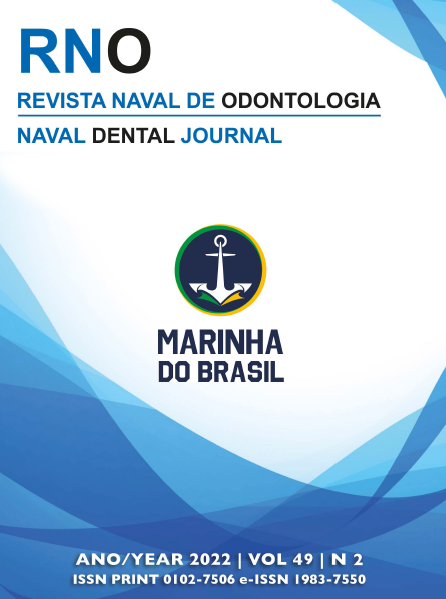Avaliação da Efetividade do Corte de Lâminas de Bisturi Após Uso e Limpeza Por Diferentes Métodos
Evaluation of the Effectiveness of Cutting Scalpel Blades After Use and leaning by Different Methods
DOI:
https://doi.org/10.29327/25149.49.2-2Palavras-chave:
Cirurgia bucal, Ferida cirúrgica, OdontologiaResumo
Na execução dos procedimentos cirúrgicos bucais e maxilofaciais o operador, ao realizar incisões, necessita de uma lâmina que garanta um corte preciso, diminuindo lesões desnecessárias aos tecidos. Ao fazer uma busca na literatura, constatou-se carência de estudos que avaliassem lâminas de bisturi de uso odontológico. Diante desse cenário, o objetivo do presente estudo foi avaliar o poder de corte de lâminas de bisturi novas e após limpeza com diferentes métodos. Sessenta lâminas de bisturi estéreis foram divididas em sete grupos: I) lâmina nova; II) segunda inserção; III) lâmina limpa com gaze; IV) lâmina limpa com gaze e soro; V) lâmina limpa com soro; VI) lâmina limpa com algodão e VII) lâmina limpa com algodão e soro. Para inserção e aferição da resistência ao corte utilizou-se uma máquina de ensaio universal (Osvaldo Filizola, São Paulo, Brasil). Os resultados revelaram que a limpeza da lâmina com gaze e soro fisiológico foi o método que teve maior perda de corte. Já a reinserção da lâmina de bisturi sem quaisquer tipos de limpeza ou a limpeza da lâmina com algodão e soro foram as que obtiveram melhor resultado, não comprometendo as propriedades mecânicas do material testado. Conclui-se, com a realização desse estudo, que os métodos de limpeza afetam o poder de corte das lâminas de bisturi.
Referências
5. Criado FJ. A brief history of the endovascular revolution and how it transformed vascular surgery and my life. J Cardiovasc Surg (Torino). 2022 Aug;63(4):439-444. 6. Nagargoje GL, Badal S, Mohiuddin SA, Balkunde AS, Jadhav SS, Bholane DR. Evaluation of Electrocautery and Stainless Steel Scalpel in Oral Mucoperiosteal Incision for Mandibular Anterior Fracture. Ann Maxillofac Surg. 2019 Jul-Dec;9(2):230-234. 7. Li H, Xie M, Mai G, Abulaiti M, Zhang Z. [Treatment of maxillofacial benign tumors by endoscope assisted concealed incision]. Lin chuang er bi yan hou tou jing wai ke za zhi = Journal of clinical otorhinolaryngology, head, and neck surgery. 2021 Mar;35 (3):269-71. 8. Mahajan RK, Gupta K, Srinivasan K, Tambotra A, Singh SM, Kaur A. Retrospective Analysis of Subtarsal Incision in Maxillofacial Trauma. J Maxillofac Oral Surg. 2020 Sep;19(3):443-446. 9. Baldassarre BM, Lavorato A, Titolo P, Colonna MR, Vincitorio F, Colzani G, Garbossa D, Battiston B. Principles of Cortical Plasticity in Peripheral Nerve Surgery. Surg Technol Int. 2020 May 28;36:444-452. 10. Cawley DT, Rajamani V, Cawley M, Selvadurai S, Gibson A, Molloy S. Using lean principles to introduce intraoperative navigation for scoliosis surgery. Bone Joint J. 2020 Jan;102-B(1):5-10. 11. Faul F, Erdfelder E, Lang AG, Buchner A. G*Power 3: a flexible statistical power analysis program for the social, behavioral, and biomedical sciences. Behav Res Methods. 2007 May;39(2):175-91. 12. Lioce CG, Davis EC, Bennett JW, Townsend FI, Bloch CP. Scalpel blade contamination and risk of postoperative surgical site infection following abdominal incisions in dogs. BMC Res Notes. 2019 Jul 25;12(1):459. 13. Chau JK, Dzigielewski P, Mlynarek A, Cote DW, Allen H, Harris JR, Seikaly HR. Steel scalpel versus electrocautery blade: comparison of cosmetic and patient satisfaction outcomes of different incision methods. J Otolaryngol Head Neck Surg. 2009 Aug;38(4):427-33. 14. Beran RF. Cleaning of ophthalmic diamond scalpels. J Refract Corneal Surg. 1994 Sep-Oct;10(5):582-6. 15. Pithon MM, Sousa EO, Amorim CS, Andrade ACDV, Coqueiro RS, Andrade RCD, et al. Análise das propriedades mecânicas de agulhas anestésicas odontológicas. Rev Assoc Paul Cir Dent. 2019;73 (3):215-18.










